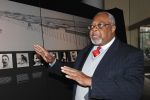On Oct. 15, the August Wilson Center for African American Culture debuted an exhibit commemorating the contributions of Black and Jewish Olympians in the 1936 Berlin Olympics. The exhibit showcases the parallel experiences of African-Americans and Jewish Europeans who faced rampant discrimination from the very countries they were competing for.
 |
|
SALA UDIN
|
“I think one of the significant things about this exhibition is that the Olympics just ended this year. This will give us an opportunity to educate people and reeducate some others,” said AWC Co-Executive Director Sala Udin. “There’s still anti-Semitism in this country. There’s still racism in this country.”
The rise of Adolf Hitler and the prevalence of anti-Semitic sentiment in Nazi Germany caused a debate in many countries about participating in the 1936 Olympics. However, while many in America considered boycotting the Olympics on moral grounds, they failed to acknowledge the similar discrimination against African-Americans in the United States.
“There were some ironies in that debate, especially in the United States where African-Americans were being very poorly treated,” said Cecile Shellman, artistic director of visual arts and exhibitions at the AWC. “When these athletes went to Europe they were mostly treated like heroes so there’s this irony.”
While an unprecedented number of countries participated in the 1936 Olympics, the Black athletes were the only Olympians of African decent. The Black Olympians were responsible for winning 14 of the United State’s medals and earning 70 of the country’s 187 points.
Nineteen African-American athletes participated in the Berlin Olympics, tripling the number of those who participated in the Los Angeles Olympics four years earlier. The most successful among them was Jesse Owens, a track and field athlete who won four gold medals, more than any other Olympian that year.
“Jesse Owens was the most storied and best known but there was at least one Pittsburgher,” Shellman said. “The Pittsburgher’s name was John Woodruff. He was from Connellsville and to this day they celebrate him in that community.”
Woodruff, who was born in Connellsville, Fayette County and graduated from the University of Pittsburgh, won the gold medal in the half-mile (800-meters today) run.
“It’s important to recognize the significance of having African-Americans represent the United States. But of course they had to return home to discrimination,” Shellman said. “We still face discrimination. The message of this exhibition is how can you overcome the hurdles today.”
While many of the Black Olympians gained notoriety and went on to overcome other barriers in employment and education, the same could not be said for many Jewish Olympians. The final section of the AWC exhibit shows the many Jewish Olympians and athletes who were killed in the Holocaust.
“Can you imagine competing for a country that doesn’t want you; these were significant hurdles,” Shellman said. “The Olympic games were kind of a catalyst for all this furor and knowledge and disdain for what Hitler was doing.”
The exhibition is on loan to the AWC, in partnership with the Jewish Federation of Grater Pittsburgh, from the United States Holocaust Memorial Museum in Washington, D.C. It will be on display through Feb. 15.